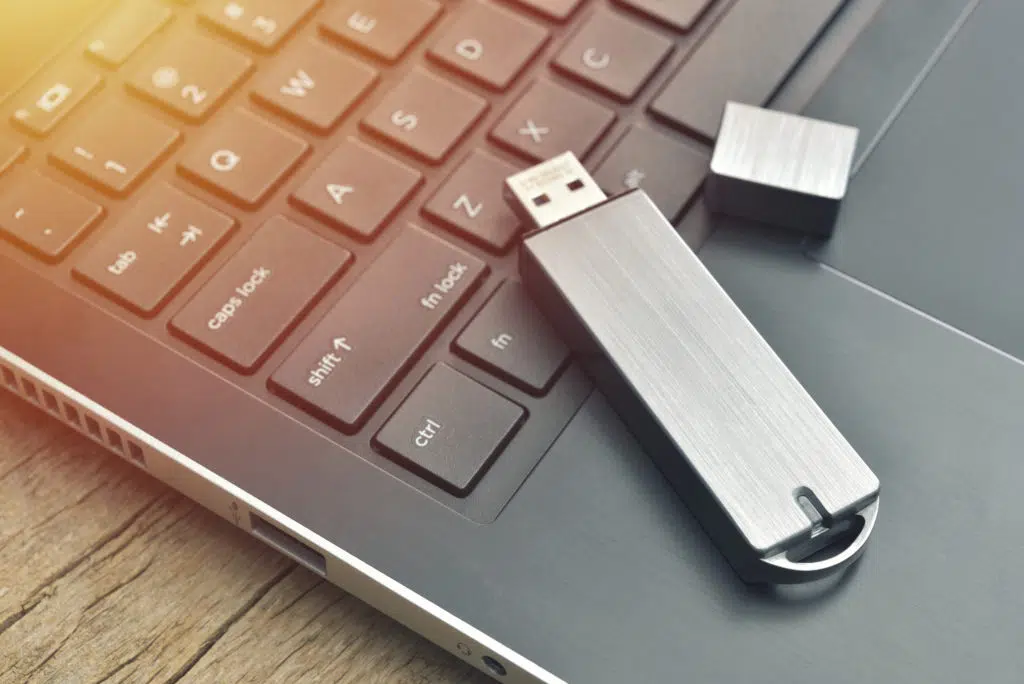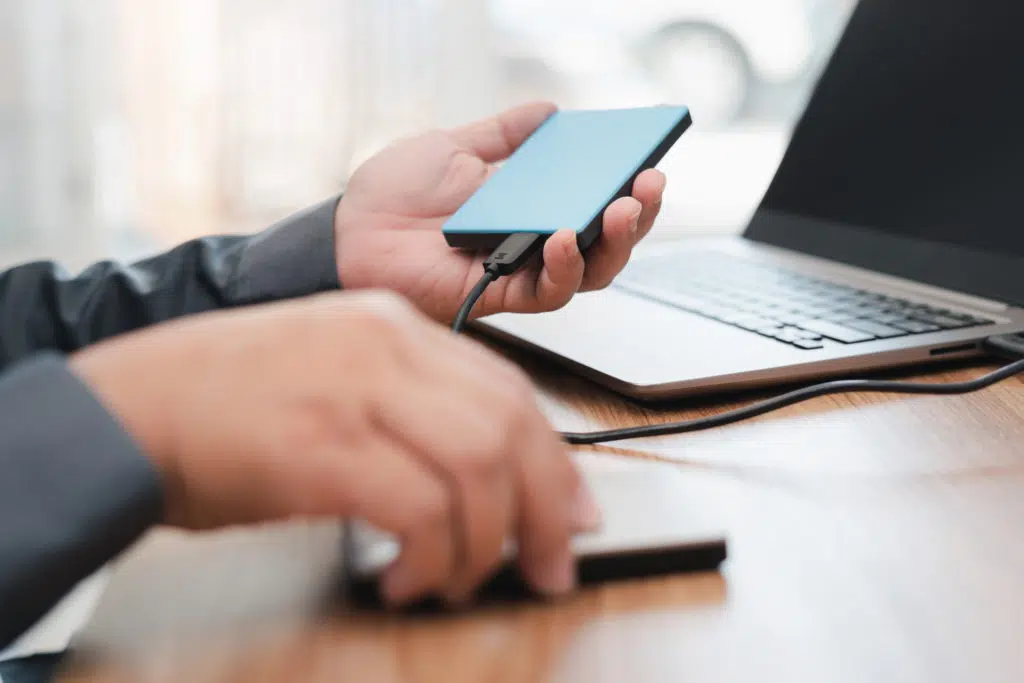Here’s how to secretly copy files off a personal or work computer without leaving a trace using to a usb drive and other methods:
There is no perfect answer, as any given file could be protected in a number of different ways.
You need a method that gets around detection, logs, and warnings, and that can range from sending an email to booting a different operating system.
The only real way is to know how the action may be traced in the first place.
So if you want to learn all about how to copy files from a computer or laptop without leaving a trace, then you’re in the right place.
Let’s get started!
Strategies for Leaving No Trace When You Copy Files From a Computer? (5 Things)

No matter how a file is protected, there are ways around any system.
It’s a matter of learning.
The first step is to find out what security measures are already in place.
From there, you can use different techniques to work around each of those measures.
You’ll find all of this in greater detail below.
#1 Learn What Security Measures Are in Place

The only way you will have a chance of copying files undetected is to first know what measures are in place to detect your potential activity.
If you don’t know what measures exist, you can’t plan around them.
Here are a few questions to help you think about what challenges might be present.
Can you access the BIOS?
BIOS (stands for basic input/output system) is where you control settings that exist at a deeper level than the operating system.
You can choose what operating system or device is used to boot, for instance.
If you don’t have access to the BIOS, you lose a lot of options.
Are files actively monitored?
Many systems use active monitoring software that will automatically create a log every time a file is copied.
This is common for classified and sensitive information.
If such monitoring is in place, you have to find a way to access the files in an environment that the monitoring system cannot reach.
Are the files encrypted?
If they are, then you need an encryption key even if you successfully copy the files without being detected.
It’s another major hurdle.
Will the system allow you to use a USB?
If files are sensitive enough, USB access can be denied.
Alternatively, the monitoring system can create alerts any time external storage is plugged into a computer.
The act of plugging in the USB could be your undoing.
When you consider all of the security in place and understand what you’re up against, you can potentially use some of the techniques below to succeed.
#2 Use a Different Operating System to Copy Files

BIOS locks make this difficult (if not impossible).
But, if you can plug in a flash drive without getting in trouble, then you have a chance to get personal or other files off a work computer undetected.
You can use a bootable USB drive with a different operating system on it.
Ubuntu is a popular choice.
This bootable USB loads an entire operating system, and that operating system works independently from the Windows (or another system) already installed on the computer you are accessing.
Let’s assume the computer that has the files you want uses Windows, just to create a clear example.
If you load Ubuntu from a USB, you skip a lot of potential problems.
When you do this, your USB operating system can access all of the computer’s hardware, but any monitoring software that runs through Windows won’t be able to load.
You’re skipping the part where the computer boots Windows.
So, you can secretly copy files (or the whole hard drive) to another USB drive, and Windows won’t be able to create logs or alerts, and monitoring software that usually runs on the computer will not be active.
In fact, the computer won’t even connect to its network by default.
The automatic connection settings are all saved in Windows.
Your Ubuntu system can connect to networks if you take the time to set it up, but that would only expose you to more potential monitoring.
As long as you can successfully load Ubuntu without detection, you can copy files without detection too.
#3 Create Email Drafts to Copy Files Leaving No Trace on Computer

In some cases, loading a USB operating system won’t be viable.
BIOS settings might prevent it. Monitoring might make that dangerous.
You also have to worry about people looking over your shoulder.
If someone walks by and sees Ubuntu running on a computer, it might raise suspicion.
A simple solution to those problems is to create an email.
Now, you have to do this with an email account that you can access outside of work.
Hopefully, that includes your work email address.
If it doesn’t, you’ll have to use a different email address, and that comes with a whole new set of risks.
Assuming you can log into an email account without creating problems for yourself, the technique is pretty simple.
Create a new email on the computer and upload the personal or work files you want to get a copy of as attachments.
Then, save the email as a draft.
Don’t ever send it.
When you leave work, you can access the email account from a different device.
Download the saved attachments, and then delete the draft.
There will never be a record of you sending an email with those attachments.
There is a caveat to this technique.
Uploading the files to your email can create logs that the files were accessed, so this will only work if you have permission to email these files in the first place.
Otherwise, this is not a good way to avoid detection.
Also: Employers Reading Your Emails: After You Leave?
#4 Image the Whole Drive

In order for monitoring software to create log notifications that a file was copied, the file has to be individually accessed.
It also has to be accessed in an environment where the monitoring software can work.
This is why the Ubuntu trick can work.
There’s another option that bypasses Windows and monitoring software.
You can create a backup of the entire hard drive.
This is regularly done, even with secure files, so there is a window of opportunity.
If you know what tools are used to create backups for the computer in question, you can use those same tools to create a backup that you then take with you.
It requires that backups exist outside of central servers and cloud solutions, but this is often the case.
You can use the same software and hardware as the IT people who manage the computer.
Clone The Computer Drive To Copy Files Without a Trace
An advanced method for imaging the whole drive involves physically pulling the hard drive from the target computer and cloning it using another laptop or computer. One popular software for this purpose is Macrium Reflect.
Here’s a step-by-step guide:
- Remove the Hard Drive: Carefully remove the hard drive from the target computer. Make sure the computer is powered off and unplugged before you do this.
- Connect to Another Computer: Use a SATA to USB adapter to connect the removed hard drive to another laptop or computer.
- Install Macrium Reflect: Download and install Macrium Reflect on the computer you’re using for cloning.
- Clone the Drive: Open Macrium Reflect and select the option to clone a disk. Follow the on-screen instructions to clone the connected hard drive to another drive or an image file.
- Complete the Process: Once the cloning is complete, you can disconnect the hard drive and place it back into the original computer.
Dealing with Encrypted Drives
If the drive you are trying to clone is encrypted, which is often the case with Windows systems, you’ll need the BitLocker key to access the drive’s contents after cloning.
- Locate BitLocker Key: Before removing the hard drive, make sure you have access to the BitLocker recovery key. This is crucial for decrypting the drive later.
- Use the Key in Macrium Reflect: During the cloning process, Macrium Reflect will prompt you for the BitLocker key. Enter it when prompted to proceed with the cloning.
- Verify Access: After cloning, use the BitLocker key to unlock the cloned drive or image and verify that you can access the files.
By following these steps, you can create an exact clone of the target hard drive, bypassing most monitoring and logging software. However, the BitLocker key is essential for accessing encrypted drives, so make sure you have it before proceeding with this method.
#5 Get Permission

There is an alternative route to take.
Instead of secretly extracting files from a computer to a USB drive or elsewhere, you could simply ask for permission to copy them.
Obviously, this will depend heavily on the circumstances.
But, it’s entirely possible that you can gain legitimate access to the files.
This prevents the need to worry about detection on any level.
You get the personal or work files off the computer, and you aren’t at risk of any of the potential fallout that comes from copying things you aren’t permitted to access.
What Happens if You Get Caught Copying Files? (4 Things)

While you are considering techniques for copying files without leaving a trace, you should think about the consequences of your actions.
What will happen if you get caught?
That mostly depends on the nature of the information in those files.
#1 If the Files Are Classified Information

Many countries have designations that legally restrict access to specific information.
These designations are usually pulled under the term “classified.”
If files are classified, it is illegal to access them or copy them outside of specified protocols.
In other words, trying to copy them without detection is probably illegal.
Depending on the value of the files, it might not even be realistic to try to copy them without being caught.
Deep redundancy is put around the most important files.
Even if you get past some detection methods, you might miss another one, and it’s unlikely that you will be able to preemptively analyze every detection technique that is deployed.
One way or another, your actions will leave a trace, and the consequences can come with steep jail time.
#2 If You Copy Protected Information Files Even with No Trace

Even if the government isn’t involved in the files you want to secretly copy, transferring files from the work computer to a personal USB drive still might be illegal.
The laws around this are a lot grayer and depend heavily on varying situations.
If you are trying to act as a whistleblower, you should be protected from copying files that prove illegal or wrongful behavior, but with limitations.
Even to “blow the whistle,” you cannot copy files that include confidential personal information (such as medical files). We will further explore whistleblower rights in a later section.
It’s tricky to navigate.
If you are not acting as a whistleblower, you have far less protection available.
Poaching information, clients, or anything else related to these files can potentially violate contracts and ethical agreements.
#3 The Stigma of Information Theft

Even if you are completely successful copying personal files or others off a work computer without leaving trace, there is still risk involved.
If you steal information from one employer to get in good with a new employer, it might not have the intended effect.
The act could make you look untrustworthy, and that comes with a new set of problems.
Even outside of that specific scenario, copying files in secret comes with consequences.
Consider Edward Snowden.
Even if he was fully pardoned, he would never be trusted with state secrets again.
In fact, it’s unlikely he could ever get a job that would grant him access to confidential files.
It’s a stigma that is hard to beat.
#4 Know Your Rights

If in spite of all of this, you still feel compelled to continue, you need to know your rights.
There are some documents that you can legally take, and you will be protected (at least in the United States).
Performance reviews (but only your own) can always be copied.
You own them.
Email exchanges that do not include classified information or information covered by NDAs (or other binding contracts) are also technically yours.
That applies to email attachments as well.
If you secretly copy files from a computer to a USB drive that you are legally allowed to copy, then even if it is detected, you should be in the clear and there may be no reason to copy these without leaving a trace.
Rights and Protections for Whistleblowers
If you are considering copying files to expose illegal or unethical activities within your organization, you may be protected under whistleblower laws. However, there are important considerations and limitations:
- Legal Framework: In the United States, laws like the Whistleblower Protection Act and the Sarbanes-Oxley Act provide some protections for whistleblowers. Similar laws exist in other countries, but the extent of protection can vary.
- Confidential Information: Even as a whistleblower, you are generally not allowed to disclose confidential or classified information. Doing so could expose you to legal repercussions.
- Reporting Channels: Many laws require that you first report the misconduct internally, through the appropriate channels within your organization, before taking the information public. Failure to do so could compromise your legal protections.
- Documentation: Keep records of all interactions, reports, and steps taken during the whistleblowing process. This can serve as evidence to protect you against retaliation.
- Legal Consultation: Before taking any action, it’s advisable to consult with a legal expert familiar with whistleblower laws and protections in your jurisdiction.
- Retaliation: While laws exist to protect whistleblowers from retaliation, such as job termination or harassment, these laws are not foolproof. Be prepared for potential challenges.
- Public Disclosure: Some laws allow for public disclosure only if certain conditions are met, such as imminent danger to public health or safety, or if the organization fails to act on the reported misconduct within a specified timeframe.
- Anonymous Reporting: Some organizations and regulatory bodies allow for anonymous reporting. However, anonymity can sometimes make it more difficult to investigate and act upon your claims.
By understanding your rights and the legal framework that protects whistleblowers, you can make more informed decisions and better protect yourself during the process.


